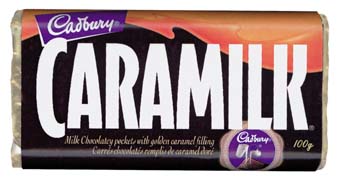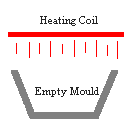
How do they get the Caramel in the Caramilk bar? After spending 10 years designing new formulae for the confectionery industry, one gets asked that question more than any other question. The short answer is that they use a shell moulding plant.

|
|
|
Sorry, no fancy enzymes or ice cold plungers for the Caramilk bars.
Artist's rendering of a Mikrovert ™ shell moulding plant.

Follow the diagrams for the long answer. P.S. The fudge works
the same way. Nay sayers scroll to the bottom of the
page.
Mould Warming
 |
Mould Filling
 |
Vibrate
 |
Drain and Vibrate
 |
Cooling
 |
Scraping
 |
Fill with Caramel
 |
Vibrate Caramel
 |
Cool Surface of Caramel
 |
Rim Warmer
 |
Flood Mould
 |
Vibrate Mould
 |
Scrape Mould
 |
Vibrate Mould
 |
Cool the Mould
 |
Demould Bar
 |
To actually manufacture the bar one starts with a empty bar mould. The mould must be warmed to 85 to 90°F so as not to ruin the temper in the coating. The mould must be designed by an expert (usually Swiss, Dane or German) so that the finished bar will demould easily and retain all of the patterns transferred from the surface of the mould. Notice the beautiful workmanship on the "Cadbury" lettering on each piece.
The prewarmed mould is now filled with tempered coating. The entire mould is filled so as to help eliminate as many bubbles as possible in the exterior of the coating's shell.
The mould is now shaken violently to remove any air bubbles in the coating. Since air is lighter than coating they float to the surface and break. The shaking just gives them a great deal of encouragement to float a little faster.
The mould is now inverted and most of the coating will drain out on its own leaving a thick skin of coating on the inside walls of the mould. A controlled amount of vibration is used to remove additional amounts of coating from the mould to give precise control over the thickness of the coating that is left in the mould. The control of the viscosity of the coating is essential at all stages of the manufacture of this bar and must precisely controlled.
The mould is cooled in the inverted position until the coating solidifies. If it was cooled in the upright position the coating would be thicker on the top than on the sides.
The edges are then trimmed. The excess coating is remelted and reused.
The caramel is deposited in the hollow shell. This must be done accurately. If there is too much caramel there will not be enough room for the back of the bar in the mould. If there is too little, one has an unhappy consumer. If there are a lot of tails left by the depositor on the edge of the mould, the bar will probably leak.
The mould with the liquid caramel is now vibrated to remove air bubbles and level the caramel across the entire cavity.
The mould is sent through a skinning tunnel. This tunnel blows cool air across the top of the mould cooling the caramel sufficiently to form a thin skin across the top of the caramel deposit. This skin must not rupture when the backing coat of compound is deposited, but it must melt when the bar is at room temperatures.
The mould is sent under a heater. This heater just barely softens the upper edge of the coating's shell, so that the back layer of coating will bond to the front shell. If to much heat is applied the temper of the coating will be destroyed and/or the skin on the caramel could be weakened. Not enough heat and the front will not bond to the back causing leakers.
The backing depositor overfills the mould with coating to ensure that all voids are filled.
The mould is vibrated heavily to remove any air bubbles.
Any excess coating is scrapped from the mould. If you look closely at the back of the bar you can see the fine marks caused by the scraper
The mould is vibrated to remove the scrape marks and remove any remaining air bubbles.
The entire mould is cooled extensively to ensure that the coating solidifies completely. During this process the outside shell of coating will pull away from the mould. Allowing the bar to be easily removed from the mould.
The bar can be removed by either inverting the mould and tapping the back of the mould so as to knock the bar out of the mould on to a conveyor or the bar can be picked out of the mould with a suction cup and placed on a conveyor. Now you have the finished bar ready for eating. Oh! I suppose you want it wrapped an shipped to you.
Bad news, the coating on the Caramilk bar has a snow balls chance in ???? of being called chocolate in North America. Why? Instead of using cocoa butter in the coating they have used Modified Palm, Modified Vegetable and Vegetable Oils. Milk chocolate should consist of approximately 45% Sugar, 25 % Cocoa butter, 18% Milk Solids, 12 % Chocolate (i.e. Unsweetened Chocolate or Chocolate or Cocoa Mass), 0.3% Lecithin , and a pinch of vanillin (i.e. artificial vanilla flavour) or vanilla if one has the big bucks. Notice: The words modified and hydrogenated are not used in real chocolate. Once a company substitutes vegetable oil for cocoa butter it is not chocolate. A great number of popular candy bars are not coated in chocolate, but are coated in compound coating instead to save money.
Cadbury Caramilk Bar Ingredients: SUGAR/GLUCOSE-FRUCTOSE, MILK INGREDIENTS, MODIFIED PALM, MODIFIED VEGETABLE AND VEGETABLE OILS, UNSWEETENED CHOCOLATE, HYDROGENATED VEGETABLE OIL, SALT, COCOA BUTTER, SOYA LECITHIN, CITRIC ACID, SODIUM BICARBONATE, CALCIUM CHLORIDE, NATURAL AND ARTIFICIAL FLAVOURS
Ingredients Cadbury uses in their real milk chocolate: SUGAR, MILK INGREDIENTS, COCOA BUTTER, UNSWEETENED CHOCOLATE, NATURAL AND ARTIFICIAL FLAVOUR
Tempering is the heat treatment of chocolate or compound coatings to ensure that the fat in the coating will crystallize with the proper crystal pattern. In cocoa butter there are four crystal patterns, alpha, beta, beta prime, gamma. Most substitute fats used in compound coatings also have to be tempered. These fats are often classified as cocoa butter equivalents. The coating is first warmed to 104°F then cooled slowly to 83-85°F. Beta crystals will begin to form. The temperature is then raised slightly to 88-90°F to reduce the viscosity of the coating. The coating is ready to be deposited. If a coating is tempered properly it has a nice shine and releases easily from the mould. If the coating is cooled too quickly alpha crystals will form. Alpha crystals are unstable and have a short life. Any product made with cocoa butter in the alpha form will quickly bloom (turn white and feel greasy). Note heat damage has the same effect. Fat migration also cause the coating to turn white and feel greasy but the feel of the coating is different. (i.e. Coated nuts and Coated Nut Butters). Coatings with Sugar bloom (condensation and drying ) also turn white but they feel gritty.
Cadbury's; caramels and fudges are not made with ordinary caramel or fudge as you probably already know. Most candy centers are cooked at high temperatures (~244°F) and quickly solidify once they are cooled. Obviously one cannot deposit caramel at 244°F in to a chocolaty coating that melts at ~92°F. To produce a caramel suitable for depositing on a shell moulding plant, one would make the caramel as per usual for a regular standup caramel or soft caramel and then add a thinning syrup. The thinning syrup can be a wide variety of substances. i.e. Sugar and glucose, High Fructose corn syrup, golden syrup. If a large amount is used it has to be inexpensive. The choice of the type corn syrup that is used can regulate a lot of the properties of the finished caramel. After the thinning syrup is added the caramel must be cooled down to not more than 100°F before it is deposited. It will lose another few degrees when it is deposited, it must not take the temper out of the coating. Hot caramel is a good way to ruin a perfectly good coating.
A few notes for the nay sayers:
Enzymes: There are no enzymes in the
ingredient list, one would see invertase, sucrovert, etc. on the list of
ingredients.
One Shot Deposit: If you look
closely it is possible to see the bond between the backing coating and initial
coating deposited in the mould. It can be spotted by breaking the backing from
the edge of the bar. In several spots around the outside edge of the bar, you
may be able to find a clean smooth surface as opposed to a rough surface. This
takes a little practise and make take you several bars to find it. But once
you do find it, the nickel will drop. One shot deposits do not have joint
marks.
Frozen caramel centers placed by
robot or human hands. If you deposit liquid chocolaty coating or chocolate on
an ice cold surface, the fat in the coating will crystallize very quickly in
the wrong crystal pattern. Which gives a poor temper which will cause a lose
of gloss and fat bloom problems. No manufacturer is going to risk getting fat
bloom if they can avoid it.
Production Volumes: According to Mikrovert (Jensen), tradition production lines are available with capacities to 10,000 kilograms per hour, One shot depositors peak at 1,200 kg/hour and their freezer cone technology peaks at 3,000 kg/hour. Which one would you choose for one of the most popular bars in the world?
† Original Site © Ian Bailey http://www3.ns.sympatico.ca/mt-edward/cadbury.htm (used with permission)